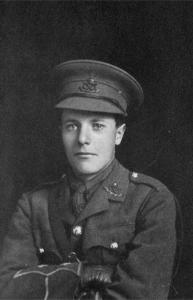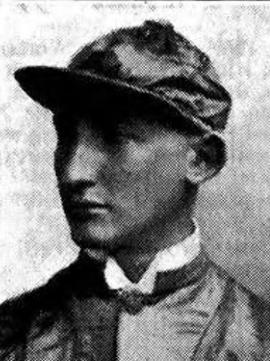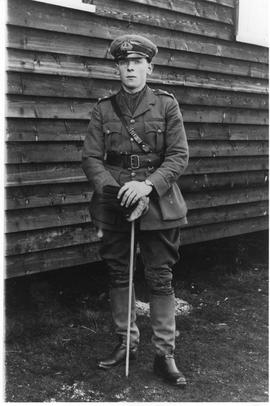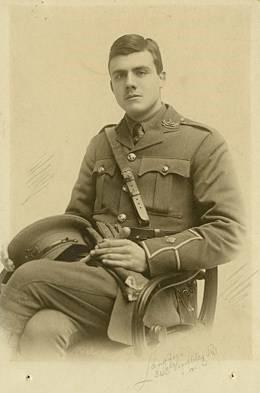Cozens, Leslie, brother of Frederick Cyril Cozens (q.v.); b. Sept. 20, 1893; adm. April 30, 1908 (A); left July 1911; entered his father's business of tanner and currier at Walsall; 2nd Lieut. 5th Batt. South Staffs Regt. May 2, 1912; Lieut. March 1, 1914; Capt. May 19, 1915; went out to the western front March 3, 1915; d. Oct. 14, 1915, from wounds received in action at the Hohenzollern Redoubt the previous day; unm.
Coventry, Wyndham John, younger son of Frank Coventry, of Twickenham, by Louisa Emily, daughter of Sir John Joseph Grinlinton, of Middle Wallop, Hants; b. Dec. 25, 1886; adm. April 23, 1902 (A); left July 1904; R. M.C. Sandhurst 1906; 2nd Lieut. (unattached) Jan. 19, 1907, 44th Merwara Infantry (Indian Army) March 12, 1908; Squadron Officer 7th Hariana Lancers July 6, 1908; Lieut. Indian Army April 19, 1909; Capt. Sept. 1, 1915; left India with drafts for the 20th Deccan Horse Dec. 7, 1914, and served on the western front as observer in the Royal Flying Corps until. June 1915; was recalled to his regiment in India, and joined the expeditionary force to Mesopotamia July 1915; took part in the battles of Kut and Ctesiphon; mentioned in despatches; d. Jan. 1, 1916, of wounds received in action at Ali Gharh, Mesopotamia, the previous day; unm.
Cooke, Guy Proudfoot, only son of David Frederick Cooke, of Teddington, Middlesex, solicitor, by Alice, widow of Arthur Proudfoot; b. Feb. 27, 1894; adm. from Uppingham School April 29, 1909 (A); left Dec. 1910; entered his father's office in Jan. 1911 and was articled to him in March 1913; joined the R. N. V. R. March 1913, and as a leading seaman took part in the operations at Antwerp in Oct. 1914; Sub-Lieut. R. N. V. R. (Nelson Batt.) Dec. 23, 1914; went out with the Mediterranean Expeditionary Force March 2, 1915; killed in action at Gaba Tepe, Gallipoli Peninsula, May 2nd, 1915; unm.
Codd, Stephen Arthur Herbert, only son of Arthur William Codd, of West Hampstead, by Florence, daughter of William Whitley, of Woodstock, co. Oxon.; b. Oct. 24, 1891; adm. as K.S. (non-resident) Sept. 28, 1905 (H); left July 1910; entered the office of the High Commissioner for South Africa, but in 1913 went to King's Coll. London with the intention of taking holy orders; gained the Wordsworth Latin Prize in the Intermediate B. D. Exam. in 1914; enlisted in the Univs. and Pub. Schools Batt. of the Royal Fusiliers Sept. 3, 1914; 2nd Lieut. 11th (Service) Batt. Gloucestershire Regt. Dec. 18, 1914; was attached to the 7th Batt. and went out to Gallipoli Sept. 24, 1915, but after the great blizzard there in Nov. was invalided home with frostbite; went out to the western front after his recovery Aug. 24, 1916; killed in action at High Wood on the Somme Sept. 9, 1916; unm.
Cockin, Maurice Herbert Battle, son of Maurice Stanley Cockin, journalist, of Mortlake, Surrey, and Alys Grace. d. of Philip Gear of Bristol; b. 17 Nov. 1915; adm. Sept. 1929 (B), (A) Sept. 1930; left July 1933; Queens' Coll. Camb., matric. 1934, BA 1937, MA 1941; N. Borneo Admin. Service; bar student (Middle Temple) 1941; HQ. Intelligence Section 1st Canadian Divn (Capt.); despatches (posth.) Sicily May 1944; killed in action 1944.
Maurice Herbert Battle “Bat” Cockin was born at Mortlake, Surrey on the 17th of November 1915 the only son of Captain Maurice Stanley Cockin, a journalist, and Alice Grace (nee Gear) Cockin of Leyden House, Mortlake. He was christened at St Mary’s Church, Mortlake on the 16th of March 1916. He was educated at Westminster School where he was up Busby’s from September 1929 and up Ashburnham from September 1930 to July 1933. He was a member of the Officers Training Corps where he achieved Certificate A. He went on to the University of Paris to study Arts from 1933 to 1934 and matriculated for Queens’ College, Cambridge in 1934 where he achieved a BA in 1937 and a MA in 1941. On leaving university he accepted a post with the North Borneo Administration Service where he was Private Secretary and Aide de Camp to the Governor of British North Borneo for nine months and was also appointed as a Magistrate. He returned to England where he studied law at the Middle Temple for two years but he enlisted in the army before he complete the course. He was fluent in German, French and Malay. He later moved to Ottawa, Canada where he worked as a civil servant for the British Government for the British Supply Board. He lived at Chateau Laurier, Ottawa.
He attended a medical examination on the 25th of May 1940 where it was recorded that he was six feet tall and that he weighed 158lbs. It was also noted that he had a dark complexion, brown eyes and brown hair. He attested for military service on the 27th of May 1940 and was commissioned as a 2nd Lieutenant in the 4th Princess Louise Dragoon Guards on the 16th of April 1940. He was attached to the Hastings and Prince Edward Regiment, was promoted to Lieutenant on the 3rd of June 1940 and joined their Depot at Picton on the same day. He left the Depot on the 3rd of February 1941 for overseas service and embarked at Halifax the following day. He disembarked at Gourock, Scotland on the 1st of March 1941. He was promoted to Captain on the 14th of November 1942 and was appointed as an Intelligence Officer 2nd Class on the 5th of February 1943. He was attached to the Intelligence Section of the 1st Canadian Division Headquarters in Italy.
On the morning of the 20th of July 1943, Maurice Cockin and Lieutenant Colonel Bruce Albert Sutcliffe went out together for a reconnaissance of the enemy front lines near Monte Assoro. As the two men crouched in the open they were spotted by the crew of a German 88mm gun which was positioned on the high ground to their front. It fired at them over open sights, killing Bruce Sutcliffe instantly and seriously wounding Maurice Cocklin.
A fellow officer saw him when he was brought back to the Canadian lines and recalled: - “Bat Cockin was still alive when they brought him back. He was in great agony, and he had apparently been asking to see me, as he had something to tell me. He and Bruce Sutcliffe had been staring up at the great peak of Assoro, and the zig-zag road that ran up to the village of that name. Although he was pretty far gone, his speech suddenly came back to him with most remarkable clarity, and he grabbed my wrist and said, "John, for God's sake don't go up that road." I don't think he spoke again.”
He was collected by the 4th Canadian Divisional Field Ambulance which took him to No. 1 Field Dressing Station where he was treated for wounds to the lumbar region of his back and to his left arm. He was also suffering from shock. He died from his wounds at 11.15am the following day.
He was Mentioned in Despatches for “Distinguished and gallant services”, which was announced in the London Gazette of the 25th of March 1944.
He is commemorated on the war memorial at Queens’ College, Cambridge and on the memorial at the Middle Temple
He is buried at Agira Canadian War Cemetery Plot C, Row G Grave 348.
Clout, Norman Charles Herbert, brother of Colin Herbert Clout (qv); b. 23 Nov. 1922; adm. Sept. 1935 (A); left July 1940; RAFVR 23 Nov. 1940, Hullavington fighter training sch. May 1941; d. of injuries in a flying accident 22 Aug. 1941.
Norman Charles Herbert Clout was born at Bromley, Kent on the 23rd of November 1922 the third and youngest son of Major Charles William Clout, London Regiment and General Staff, and Mary Ellen (nee Weekes) Clout of Camden Ridge, Chislehurst in Kent, later of 44, Montrose Avenue, Sidcup in Kent. He was educated at Westminster School where he was up Ashburnham from September 1935 to July 1940.
He enlisted in the Royal Air Force Volunteer Reserve on the 23rd of November 1940 and was posted to No. 9 Flying Training School based at RAF Hullavington for pilot training in May 1941.
Norman Clout took off from in Hurricane Mk I N2402 on the 21st of August 1941 for a solo training flight. At the time he had accumulated a total of 65.55 hours of solo flying time, of which 8.25 hours were on Hurricanes.
Having completed the exercise he was diverted to RAF Shawbury, possibly due to poor weather. When he arrived over the airfield at 5.30pm he made a circuit before approaching the runway to land. On landing he overshot the landing point and touched down three quarters of the way down the runway where the aircraft bounced into the air, most probably because he had applied the brakes. The aircraft skidded along the ground and turned over onto its back causing extensive damage to the fuselage, fins and rudder.
He was taken to the Royal Salop Hospital at Shrewsbury suffering from concussion and fractures to the third and fourth cervical bones in his neck. He had paraplegia in both of his arms and legs. He was transferred to the Royal Air Force Hospital, Cosford where he died from his injuries the following day.
His mother received the following telegram dated the 22nd of August 1941: - “Regret to inform you that your son 1330092 LAC Norman Charles Clout died in RAF Hospital Cosford near Wolverhampton on 22/8/41 as result of a flying accident on evening of 21/8/41 and tender deepest sympathy. Should you desire a private funeral coffin will be sent to railway station nearest your home, date and time of arrival being notified to you by telegram later, otherwise service funeral will be held at Cosford. If you desire to attend and cannot afford expenses one railway warrant will be issued on presentation of this telegram at the nearest police station. Please telegraph your decision as soon as possible. Your son Lieutenant C.H. Clout at Park Hall Camp, Oswestry, is being informed by me. Flying Officer L. H. Spencer”
His funeral took place on the 27th of August 1941.
He is buried at Chislehurst Cemetery Section A, Grave 2190.
Clark-Kennedy, Archibald Douglas Hewitt, brother of William Hew Clark-Kennedy (q.v.); b. July 30, 1888; adm. Sept. 25, 1902 (A); left Dec. 1903; a clerk in the Standard Life Assurance Company's office in Edinburgh and afterwards at Bombay; returned from India in 1914 and entered the Law Union and Rock Assurance Company's Office in London; 2nd Lieut. 5th Batt. Royal Scots Fusiliers; Lieut. July 12, 1915; temp. Capt. Sept. 18, 1915, Capt. Jan. 18, 1916; joined the Gallipoli expedition May 1915, and was invalided to Cyprus; returned to Gallipoli and afterwards served with the Egyptian Expeditionary Force in Palestine, where he commanded an armoured train in 1917; was transferred with his regt. to the western front in April 1918; mentioned in despatches; killed in action in France Sept. 18, 1918; unm.
Clark-Kennedy, Alexander Kenelm, brother of William Hew Clark-Kennedy (q.v.); b. Dec. 18, 1883; adm. Sept. 22, 1898 (A); left July 1902; Trin. Coll. Camb., matric. Michaelmas 1902; B.A. 1905; one of H. M. Inspectors of Factories July 31, 1906; acted as secretary to the Employ ment of Children Act 1909; 1st division clerk in the Home Office. Jan. 15, 1912, but was reappointed an Inspector of Factories Aug. 13, 1912; hon. sec. of the Elizabethan Club 1912-3; 2nd Lieut. the Galloway Rifles (afterwards known as the 5th Batt. of the King's Own Scottish Borderers) Oct. 19, 1906; Lieut. Aug. 20, 1907; Capt. July 12, 1915; went out to Gallipoli in May 1915; invalided home in Oct. 1915; joined his batt. in Egypt April 1916; killed in action near Gaza, Palestine, April 19, 1917; unm.
Clarke, Edwin Charles Kay, only son of Charles Sidney Clarke, of Laughton, Essex, stockbroker, and Elizabeth Clarke; b. Oct. 29, 1890; adm. Sept. 26, 1901 (R); left July 1910; joined the Inns of Court O. T. C. in 1911; 2nd Lieut. Oct. 18, 1914; Lieut. June 8, 1915; Officer Cadet Batt. March 20, 1916; Capt. March 23, 1916, attached to 8th Batt. London Regt. May 1918, and went out to the western front; M.C. Oct. 15, 1918; killed in action while leading an attack on Massiere's Wood Aug. 31, 1918.
Clark, Charles Peter, son of Charles Harold Clark of Clairac, Lot-et-Garonne, France, and Gladys Mary, d. of Rev. James Morell Blackie of Cheltenham; b. 5 June 1909; adm. Sept. 1922 (G); left Dec. 1926; man. Charles and William Clark & Co, Clairac; RAFVR 1941 -5 (acting Flt Lieut.), despatches (posth.) June 1945; m. 27 June 1936 Cynthia Loveday, d. of Arnold Leslie Thackhall Browelt, solicitor, of Coventry; killed in action 29 Sept. 1944.
Charles Peter Clark was born on the 5th of June 1909 the son of Charles Harold Clark, a director of a catering company and a prune manufacturer, and Gladys Mary (nee Blackie) Clark of Clairac, Lot-et-Garonne in France and of “Eastwood”, 77, Red Road, Barnet in Hertfordshire. He was educated at Westminster School where he was up Grant’s from September 1922 to December 1926. He later became the manager of the family firm of Charles and William Clark & Co of Clairac in France. He was married at Leamington, Warwickshire on the 4th of July 1936 to Cynthia Loveday (nee Browett) of Beauchamp Avenue, Leamington Spa. They had a daughter, Caroline, born on the 15th of June 1939.
Following the outbreak of war he returned to England from France where he enlisted in the Royal Air Force Volunteer Reserve and rose to the rank of Sergeant before being commissioned as a Pilot Officer on the 1st of September 1941, with seniority from the 28th of July 1941. He was promoted to Flying Officer on the 1st of September 1942, with seniority from the 28th of July 1942 and was later promoted to Acting Flight Lieutenant.
He was posted to the Air Ministry in 1943 and joined the headquarters of the Special Operations Executive at Baker Street where he worked in supporting resistance operations in occupied Europe. He was later attached to 161 (Special Duties) Squadron.
Charles Clark took off from Le Bourget, Paris at 1.15pm on the 29th of September 1944 as a passenger in Lysander Mk IIIA V9749 MA-M for a flight to his home base of RAF Tempsford. The aircraft failed to arrive and is thought to have come down into the sea killing all on board.
The passengers and crew were: -
Flight Lieutenant James Alan Lamberton (161 Squadron) (Pilot)
Squadron Leader Anthony Wilfred Alwyne Compton (161 Squadron)
Major John Walter Saunders MBE (Royal Corps of Signals)
Flight Lieutenant Charles Peter Clark (161 Squadron)
He was Mentioned in Despatches, which was announced by the Air Ministry on the 14th of June 1945.
He is commemorated on the Runnymede Memorial Panel 201.



